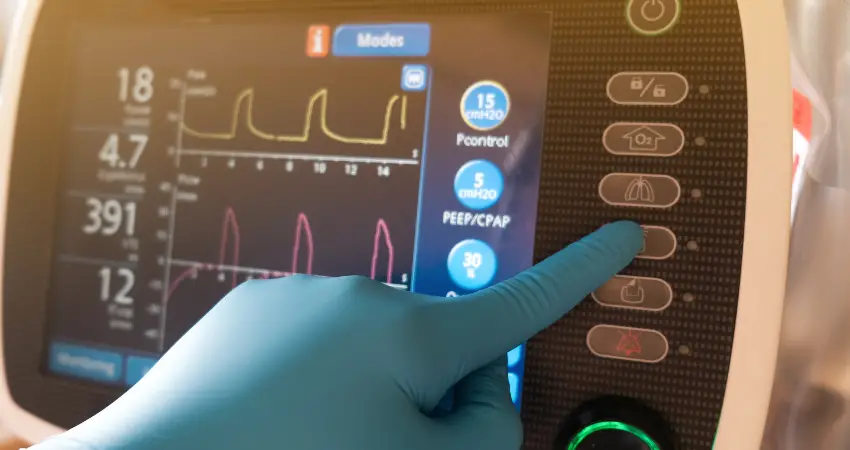Amyotrophic Lateral Sclerosis (ALS): 5 Nursing Diagnosis Care Plans

What is Amyotrophic Lateral Sclerosis (ALS)
ALS, or Amyotrophic Lateral Sclerosis, is a disease that affects the nerve cells in your brain and spinal cord.
These nerve cells, also known as neurons, control the muscles that allow you to move, speak, breathe, and eat.
Over time, ALS weakens these neurons, making it harder for them to send signals to your muscles.
This leads to muscle weakness, making it tough to do everyday tasks like walking, talking, and eating. Eventually, it may even become hard to breathe.
The exact cause of ALS isn’t known, and as of now, there’s no cure.
But there are treatments to help manage the symptoms and make life better for those who have it.
Amyotrophic Lateral Sclerosis (ALS): 5 Nursing Diagnosis Care Plans
It’s a pretty rare disease, affecting a small number of people. However, it is serious and gets worse over time, which is why medical and nursing care is crucial for managing symptoms and maintaining quality of life.
ALS is also known by another name, Lou Gehrig’s disease, named after a famous baseball player who had it.
The disease can affect anyone, regardless of age or background, although it’s more common in older adults.
In summary, ALS is a disease that impacts your ability to move, speak, and eventually breathe, by affecting the nerve cells in your brain and spinal cord.
It’s a serious condition that requires ongoing medical care.

Common Symptoms of ALS
- Muscle Weakness: One of the first signs usually noticed. This might mean difficulty lifting things, climbing stairs, or even tripping while walking.
- Speech Changes: Trouble speaking clearly, slurring words, or speaking softly are often early symptoms.
- Difficulty Swallowing: It might become hard to swallow food and liquids, leading to choking or coughing.
- Twitching and Cramping: Muscle twitching and cramps can happen, especially in the hands and feet.
- Poor Coordination: Tasks that need good hand-eye coordination, like buttoning a shirt, become challenging.
- Breathing Issues: As the disease progresses, it can affect the muscles that help you breathe. This might make it hard to breathe deeply or even lead to shortness of breath.
- Fatigue: Feeling more tired than usual, especially after physical activity.
- Stiff Muscles: Muscles may feel tight and hard to move.
- Uncontrolled Movements: Some people experience shakes or jerky movements.
- Loss of Emotional Control: Although less common, some people experience emotional changes like laughing or crying very easily.
Late-Stage Symptoms
As the disease gets worse, people may also experience:
- Total loss of movement, needing a wheelchair for mobility.
- Severe difficulty in speaking and swallowing.
- Major breathing issues, possibly requiring a ventilator.
What To Do If You Have Symptoms
If you or someone you know is showing signs of ALS, it’s crucial to see a healthcare provider for a diagnosis and to discuss treatment options. While there’s no cure for ALS, there are treatments that can help manage the symptoms and improve quality of life.
How Should the Nurse Do the Assessment?
When a nurse is assessing a patient with ALS, there are several key areas to focus on. The nurse’s assessment can help in creating a care plan that addresses the patient’s specific symptoms and needs. Here’s a rundown of what should be included:
General Health and History
- Medical History: Check for past illnesses, surgeries, and family history of neurological conditions.
- Medication Review: Make a list of all current medications and supplements.
- Lifestyle Factors: Examine habits like diet, exercise, and smoking.
Neurological Assessment
- Cognitive Function: Test memory, reasoning, and other cognitive abilities.
- Reflexes and Coordination: Check reflexes and assess coordination.
Physical Assessment
- Muscle Strength: Examine muscles for signs of weakness, twitching, or stiffness.
- Range of Motion: Evaluate joint movement and any limitations.
- Skin Condition: Check for pressure ulcers or other skin issues, especially if mobility is limited.
Respiratory Assessment
- Breathing Patterns: Observe rate, depth, and ease of breathing.
- Oxygen Saturation: Use pulse oximetry to measure oxygen levels in the blood.
Speech and Swallowing
- Speech Clarity: Assess for slurred speech or difficulty in forming words.
- Swallowing Ability: Evaluate for signs of difficulty or choking during swallowing.
Nutritional Assessment
- Weight: Record the patient’s weight and note any significant changes.
- Diet History: Discuss eating habits, noting any difficulty in chewing or swallowing.
Emotional and Psychosocial Assessment
- Mood: Assess emotional well-being, looking for signs of depression or anxiety.
- Social Support: Evaluate the level of family and social support available.
Functional Assessment
- Daily Activities: Check the patient’s ability to perform daily tasks like eating, dressing, and toileting.
- Mobility: Assess the need for walking aids or wheelchairs.
Goals and Concerns
- Patient Goals: Discuss the patient’s goals for treatment and quality of life.
- Concerns and Questions: Address any concerns or questions the patient or family might have.
After the assessment, the nurse should document the findings, share them with the healthcare team, and use them to develop a tailored care plan. This should include both medical treatments and supportive care to help manage symptoms and maintain the best possible quality of life.

Nursing Diagnosis 1:
Respiratory Distress related to weakened respiratory muscles, as evidenced by shortness of breath and shallow breathing.
| Interventions | Rationale |
|---|---|
| 1. Monitor oxygen levels. | To make sure the patient is getting enough oxygen. |
| 2. Encourage deep breathing exercises. | Helps the lungs to work better. |
| 3. Position patient in a semi-Fowler’s. | Makes breathing easier by opening up the chest. |
| 4. Keep suction equipment handy. | To remove mucus that could block airways. |
| 5. Use ventilator if necessary. | Assists in breathing when muscles are weak. |
| 6. Regularly check lung sounds. | Detect any abnormalities early. |
| 7. Administer prescribed medications. | Meds can help control symptoms. |
| 8. Limit fluid intake before bedtime. | Reduces the risk of aspiration. |
| 9. Consult respiratory therapist. | Specialized advice can optimize care. |
| 10. Educate family on respiratory care. | Helps in home management of symptoms. |
Goals:
- Improve respiratory function.
- Reduce episodes of respiratory distress.
Outcomes:
- Patient will show stable oxygen levels above 95%.
- Patient reports reduced episodes of shortness of breath within one week.
Nursing Diagnosis 2:
Impaired Mobility related to muscle weakness as evidenced by limited range of motion and difficulty walking.
| Interventions | Rationale |
|---|---|
| 1. Assist with daily movements. | Keeps the patient active and reduces stiffness. |
| 2. Use mobility aids. | Gives support to move safely. |
| 3. Regularly reposition the patient. | Helps prevent pressure sores. |
| 4. Perform passive range-of-motion exercises. | Keeps joints flexible. |
| 5. Apply warm compresses to stiff joints. | Helps in easing muscle tension. |
| 6. Encourage self-care activities. | Promotes a sense of independence. |
| 7. Assess for pain before activities. | Helps tailor intervention for comfort. |
| 8. Use anti-slip mats and handrails. | Prevents accidental falls. |
| 9. Consult with physiotherapist. | For tailored exercise plans. |
| 10. Educate caregivers on safe transfer techniques. | Reduces risk of injury during transfers. |
Goals:
- Improve patient’s mobility.
- Minimize risk of falls and injuries.
Outcomes:
- Patient will demonstrate increased range of motion in one week.
- Patient reports fewer episodes of falling or feeling unstable within two weeks.
Nursing Diagnosis 3:
Difficulty in Swallowing related to impaired muscle control as evidenced by choking or coughing during meals.
| Interventions | Rationale |
|---|---|
| 1. Monitor for signs of choking. | Early detection can prevent serious issues. |
| 2. Keep patient upright during meals. | Gravity aids in swallowing. |
| 3. Use thickening agents for liquids. | Makes swallowing easier. |
| 4. Offer small, frequent meals. | Easier to manage and less tiring. |
| 5. Encourage swallowing exercises. | Strengthens swallowing muscles. |
| 6. Keep suction equipment nearby. | Can quickly clear airway if needed. |
| 7. Assess for pocketing of food. | Ensures all food is swallowed. |
| 8. Limit distractions during meals. | Allows focus on swallowing. |
| 9. Consult with a speech therapist. | For expert advice on swallowing techniques. |
| 10. Educate caregivers on feeding techniques. | Helps maintain nutrition and safety at home. |
Goals:
- Enhance safe swallowing.
- Maintain adequate nutritional intake.
Outcomes:
- No episodes of choking or aspiration during meals for a week.
- Stable weight over two weeks.
Nursing Diagnosis 4:
Impaired Verbal Communication related to muscle weakness of the throat and face, as evidenced by slurred speech and difficulty forming words.
| Interventions | Rationale |
|---|---|
| 1. Use communication boards. | Helps when verbal communication is tough. |
| 2. Encourage the use of gestures. | Adds another layer to communication. |
| 3. Keep conversations short and simple. | Limits the energy needed to communicate. |
| 4. Regularly moisten lips and mouth. | Dry mouth can make speaking even harder. |
| 5. Use a microphone or amplifier if needed. | Enhances volume of speech. |
| 6. Keep a notepad and pen handy. | For writing when speaking is not possible. |
| 7. Use technology-assisted speech devices. | Helps when natural speech is not possible. |
| 8. Speak directly facing the patient. | Easier for them to understand and lip-read. |
| 9. Consult speech therapist. | Specialized guidance on improving speech. |
| 10. Educate caregivers on communication aids. | Helps in effective communication at home. |
Goals:
- Improve quality of verbal communication.
- Increase confidence in social interactions.
Outcomes:
- Patient will successfully use at least one form of communication aid.
- Reduced frustration during communication as reported by patient or caregiver within a week.
Nursing Diagnosis 5:
Risk for Social Isolation related to physical limitations and communication challenges as evidenced by withdrawal from social activities.
| Interventions | Rationale |
|---|---|
| 1. Encourage family visits. | Maintains social connections. |
| 2. Set up video calls with friends. | Technology can bridge the physical gap. |
| 3. Join support groups. | Offers emotional support and socialization. |
| 4. Encourage outdoor activities when possible. | Boosts mood and breaks monotony. |
| 5. Use social media for connections. | Can socialize without physical effort. |
| 6. Include patient in care decisions. | Promotes a sense of control and inclusion. |
| 7. Provide magazines, books, or music. | For personal enjoyment and mental stimulation. |
| 8. Assess emotional status regularly. | Helps catch early signs of depression. |
| 9. Encourage hobbies that can be done easily. | Keeps the mind engaged. |
| 10. Educate caregivers on signs of depression. | Helps in early intervention if needed. |
Goals:
- Increase social interaction.
- Reduce feelings of loneliness.
Outcomes:
- Patient will participate in at least one social activity in the next two weeks.
- Patient reports a decrease in feelings of loneliness within a month.
Educating the Patient and the Family
ALS: Top 10 Tips for Patient and Family Education
Living with ALS is challenging, not just for patients but also for their families. Education is key to managing this condition effectively. Here’s a listicle of the top 10 things both patients and families should know.
1. Understand What ALS Is
- Why It’s Important: Knowing what ALS is and how it progresses helps you prepare for what’s to come.
- Tip: Gather reliable information from doctors and trusted sources like the ALS Association.
2. Recognize Early Symptoms
- Why It’s Important: Early detection can lead to a better management plan.
- Tip: Look out for signs like muscle weakness, speech issues, and difficulty swallowing.
3. Get the Right Treatment
- Why It’s Important: While there’s no cure, treatments can help manage symptoms.
- Tip: Always consult your healthcare provider for personalized treatment plans.
4. Work with a Multidisciplinary Team
- Why It’s Important: ALS affects various aspects of health, from mobility to breathing.
- Tip: Work with a team of specialists like neurologists, physical therapists, and respiratory therapists.
5. Keep Active Within Limits
- Why It’s Important: Exercise can help maintain muscle strength and improve mood.
- Tip: Consult a physical therapist for a tailored exercise plan that’s safe for you.
6. Make Home Modifications
- Why It’s Important: As mobility decreases, home safety becomes crucial.
- Tip: Consider installing grab bars, ramps, and stairlifts to make navigation easier.
7. Plan for Breathing Support
- Why It’s Important: ALS can affect breathing muscles.
- Tip: Learn about options like ventilators and when you might need them.
8. Address Nutritional Needs
- Why It’s Important: Difficulty in swallowing can make eating challenging.
- Tip: Consult a dietitian for meal plans and learn how to use feeding tubes if necessary.
9. Emotional and Mental Health Matters
- Why It’s Important: Depression and anxiety are common but often overlooked.
- Tip: Seek psychological support through counseling or support groups.
10. Open Communication is Crucial
- Why It’s Important: It can become hard to speak, but communication should not stop.
- Tip: Learn to use communication aids like boards or electronic devices.
Remember, you’re not alone. There’s a community of healthcare providers, fellow patients, and families to support you. Stay educated, stay strong, and don’t hesitate to seek help when needed.
Related Articles
Nursing diagnosis for heart failure
Care plans for Parkinson disease
Methyldopa nursing responsibilities
How to take manuka honey for ibs
Glioblastoma Nursing Care Plans
Resources
https://pubmed.ncbi.nlm.nih.gov/32453150/
Phyllis Robinson MSN, RN is a Registered Nurse of 27 years. Phyllis is passionate about the prevention and healing of heart disease using traditional and alternative methods. She has experience in emergency room, telemetry, infusion, and critical care. Phyllis currently practices in an intensive care unit.

